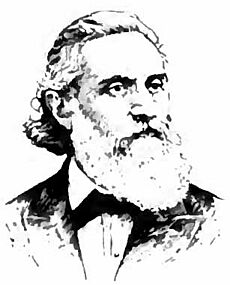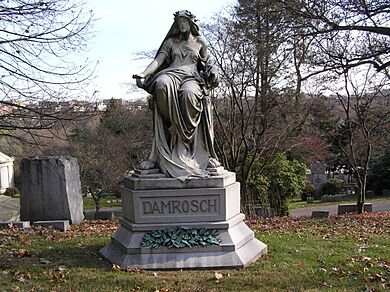Leopold Damrosch facts for kids
Leopold Damrosch (born October 22, 1832 – died February 15, 1885) was a famous German American conductor and composer. He was known for bringing classical music, especially operas and symphonies, to many people in the United States.
Contents
Leopold Damrosch's Early Life and Musical Journey
Leopold Damrosch was born in Posen (now Poznań), which was part of Prussia at the time. His father was Jewish and his mother was Lutheran. Leopold became a Lutheran when he married Helene von Heimburg, an opera singer.
Leopold started learning the violin when he was nine years old. His parents wanted him to become a doctor, but he loved music more. He went to the University of Berlin and earned a PhD in medicine. However, in his free time, he kept studying the violin and music theory. After getting his degree, he decided to follow his passion for music.
He quickly became known as a talented violinist, playing for large audiences in cities like Berlin and Hamburg. He then went to Weimar, where the famous composer Franz Liszt welcomed him. Liszt even made him the solo violinist in the Ducal orchestra.
Some people mistakenly thought Liszt dedicated a piece called Tasso: lamento e trionfo to Damrosch. However, Liszt actually dedicated another piece, Le Triomphe funèbre du Tasse, to Damrosch. Leopold Damrosch conducted its first performance in New York in 1877.
Leading Orchestras and Choirs
Leopold Damrosch first conducted an orchestra in 1859, leading the Philharmonic concerts in Breslau. He was so successful that he continued to conduct for three years. In 1862, he started his own symphonic society in Breslau. This group had eighty musicians and was inspired by the famous Gewandhaus concerts in Leipzig.
His society became well-known across Germany. Damrosch invited both Franz Liszt and Richard Wagner to conduct some of their own music with his orchestra, and they both accepted.
In 1871, Damrosch moved to the United States. He was invited by the Arion Society of New York. When he first performed in the U.S., he showed his skills as a conductor, composer, and violinist. His first performance in New York was a big success in May 1871. He played Beethoven's Violin Concerto as a solo violinist with the New York Philharmonic.
In 1873, he founded the Oratorio Society of New York. This group performed works by famous composers like Johann Sebastian Bach and George Frideric Handel. In 1874, they performed Handel's Samson with a full orchestra. Later that year, they performed Handel's Messiah for Christmas.
In 1876, Damrosch took over as the conductor of the New York Philharmonic. However, his choice of advanced music, like an entire act of Wagner's Die Walküre, was a bit too much for some of the audience at the time. So, his time with that orchestra ended.
In 1877, Damrosch helped create the Symphony Society. This group worked closely with the Oratorio Society, and they often performed together. Their biggest event was a huge "musical festival" held in a large armory in New York from May 3 to 7, 1881.
This festival was enormous! The main choir had 1,200 singers, with more choirs joining from nearby towns. An extra 1,000 young ladies and 250 boys also sang in afternoon concerts. The orchestra had 250 musicians, and many famous solo artists performed. They played major works like Handel's Dettingen Te Deum and Messiah, and Beethoven's Ninth Symphony. Between 8,000 and 10,000 people attended each concert. Everyone was very excited about Damrosch's work. In 1880, he received an honorary Doctor of Music degree from Columbia University.
In 1883, Damrosch toured the western United States with his orchestra. In September 1884, he became the General Manager and chief conductor of the Metropolitan Opera in New York. The opera company had lost a lot of money the previous season. So, they asked Damrosch to lead the company with German operas.
He brought in some of the best German opera singers. Every part, even the smallest, was performed with great care. They performed twelve operas that were new to many audiences, including Wagner's Tannhäuser, Lohengrin, and Die Walküre, and Beethoven's Fidelio.
This opera season was Damrosch's last big project. He conducted almost every performance. Sadly, he caught a severe cold during the last week of his life and never recovered. He passed away in New York City in 1885. His funeral was held at the Metropolitan Opera House. He was buried in Woodlawn Cemetery in The Bronx, New York City.
Leopold Damrosch's Family
Leopold Damrosch had two sons, Frank Damrosch (born 1859) and Walter Damrosch (born 1862). Both of them followed in their father's footsteps and became conductors of the Oratorio Society of New York. His daughter, Clara Mannes, became a music teacher. His grandchildren included the musician Leopold Mannes, the writer Marya Mannes, and the artist Helen Damrosch Tee-Van. Damrosch Park at the Lincoln Center in Manhattan is named after this musical family.
Leopold Damrosch's Compositions
Leopold Damrosch composed many pieces of music, including:
- Am Manzanares, Op. 11, no. 10
- An, Op. 8, no. 5
- An den Mond, Op. 17, no. 4
- Bedeckt mich mit Blumen, Op. 11, no. 3
- Bedeckt mich mit Blumen, Op. 11, no. 7
- Bitte, Op. 5 no. 1
- Cantatas 1–7
- Das Meer erstrahlt im Sonnenschein, Op. 16, no. 1
- Dereinst, dereinst, Op. 11, no. 4
- Dich lieb' ich inniglich, Op. 7, no. 3 (E. Kern)
- Die blauen Frühlingsaugen, Op. 13, no. 3
- Die du bist so schön und rein, Op. 10, no. 3
- Es war ein alter König, Op. 10, no. 4
- Fantasie for Violin and Orchestra
- Frühling, Op. 16, no. 2
- Frühlingslied, Op. 6, no. 3
- Geh, Geliebter, geh jetzt!, Op. 11, no. 6
- Hör' ich das Liedchen klingen, Op. 10, no. 2
- Ich halte ihr die Augen zu, Op. 16, no. 4
- Ich hatte einst ein schönes Vaterland, Op. 13, no. 2
- Ich liebe dich, Op. 8, no. 1
- In der Ferne, Op. 10, no. 1
- Jedweder Geselle, sein Mädel im Arm, Op. 16, no. 5
- Kalt und schneidend weht der Wind, Op. 8, no. 8
- Kommen und Scheiden, Op. 5, no. 4
- Liebesfrühling, Op. 5, no. 5
- Liebesgruss, Op. 14, no. 1 (Volkslieder (Folksongs))
- Lied des Fischerknaben
- Mädchen mit dem roten Mündchen, Op. 10, no. 6
- Mignon, Op. 17, no. 2
- Nachhall, Op. 5, no. 2 ((Ignaz) Julius Lasker)
- Nachtgesang, Op. 17, no. 3
- Nähe des Geliebten, Op. 17, no. 1
- Nelken wind' ich und Jasmin, Op. 11, no. 5
- Orchesterstück (1859)
- Schiller's Joan of Arc
- Siegfrieds Schwert
- Sulamith
- Symphony in A major (1878)
- Trost, Op. 8, no. 6 (Joseph Christian Freiherrn von Zedlitz)
- Violin Concerto in D minor (published in 1878). He wrote at least two violin concertos.
- Von dem Rosenbusch, o Mutter, Op. 11, no. 2
- Wandl' ich in dem Wald des Abends, Op. 16, no. 3
- Wenn ich auf dem Lager liege, Op. 10, no. 5
- Wenn ich ihn nur habe, Op. 7, no. 2
- Wieder möcht' ich dir begegnen, Op. 8, no. 9
- Zuléikha, Op. 6, no. 2
- Zuversicht, Op. 5, no. 3 ((Ignaz) Julius Lasker)




